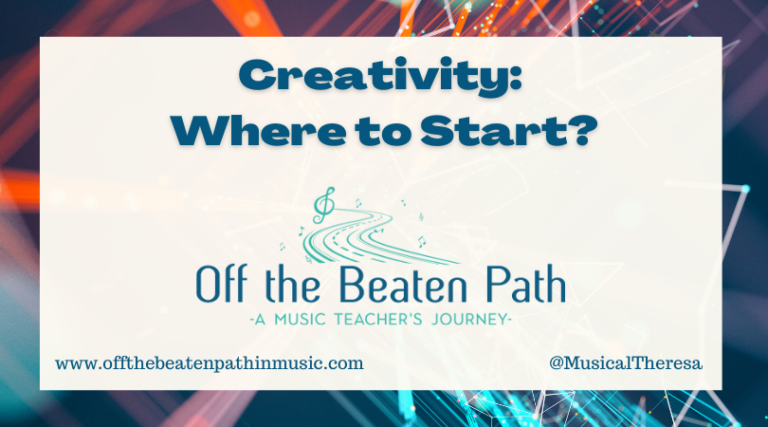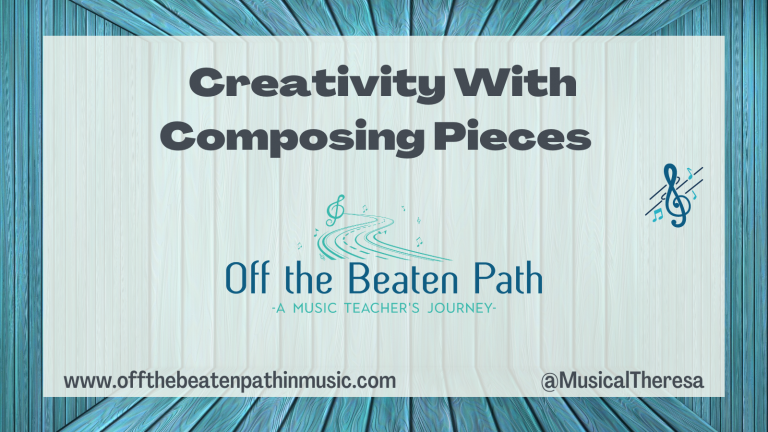What Does It Mean To Be Creative?
Creativity is a word we hear often in education, especially in music education, and it’s something I’ve become quite passionate about in the last few years. How are we, as music educators, offering opportunities for students to be creative? When do students get to create their own music and make their own musical decisions, instead of only recreating someone else’s music and performing music as dictated by someone else?
This semester I am taking a graduate course called, “Listening and Creating,” taught by Dr. Sandra Stauffer. Among other things, Dr. Stauffer has done incredible research on children and music, and creating music! This series of blog posts on creativity not only fulfills a course requirement, but will hopefully also provide information and ideas on how to cultivate creativity in your music rooms as well.
Where did it start?
To start off, let’s look at what it means to be creative. Going back to ancient times, people believed thoughts did not come from the person, but were actually whisperings from the gods. As a result, creativity was associated with madness, because if the gods were whispering to you, you must be mad! It wasn’t until the early 1900s that psychologists started to understand that people could control their thoughts. In 1926, Graham Wallas, an English social psychologist, published his last book, The Art of Thought, which included his belief that individuals went through four stages of controlled thought: preparation, incubation, illumination, and verification.
Here are the four stages in a little more detail:
- Preparation – learning about the problem or task, gathering information to solve a problem or answer a question
- Incubation – when you walk away from the task or problem, taking a mental rest. This could include working on something else, physical activity, or actually resting!
- Illumination – the flash or spark when a new idea or solution occurs! This is often unexpected and somewhat sudden.
- Verification – when you test the new idea, check the solution, and look for more information as needed.
Many elements of this process feel very familiar to me, and I imagine others as well! I can especially resonate with the “incubation” stage. I’ve often felt some of my best ideas/solutions occur when I’m walking the dog or taking a shower. While Wallas didn’t specifically relate the four stages to creative thinking, he believed being aware of this process could help people become more artful thinkers. Over the years, his work has frequently been cited in relation to thinking, intelligence, and creativity. Some scholars have criticized the four stages for being too linear, which may be valid, but overall it’s a good starting point.

It’s not the process, it’s the person
Fast forward a few years, and psychologist-behaviorist J. P. Guilford begins to wonder about the person attached to this process. What starts as an interest in intelligence tests leads him to investigate the characteristics of the creative personality. Guilford believes the process is not as important as the person. Among other things, Guilford wrote about “divergent production” and “convergent production” as two ways of thinking. Convergent thinking is more logical and analytical and often involves formal rules. Divergent thinking is more innovative and can often lead in several directions or pathways. People who are divergent thinkers can often generate multiple ideas or multiple solutions to a problem. At one point, it was assumed that divergent thinking was the same as creative thinking, but scholars now believe a combination of both is actually needed. Guilford’s interest and work really opened the door for future scholarship in creativity. To learn more about convergent and divergent thinking, check out this video by educator/author John Spencer: Convergent Thinking Versus Divergent Thinking.
In fact, E. Paul Torrance was one person who built on Guilford’s work. Torrance was also interested in studying the creative person, and in 1966, published the “Torrance Tests of Creative Thinking,” (TTCT) which measured fluency, flexibility, originality, and elaboration – very similar to Guilford’s ideas about divergent thinking! Torrance believed that creative thinking skills could – and should – be practiced, and that was actually one goal of the test. Interested in learning more about the test? Check out this video: An Overview of the Torrance Tests of Creative Thinking (TTCT).
Where is creativity?
To look at one more psychologist’s ideas about creativity, we move to Mihaly Csikszentmihalyi. While Torrance and Guilford were focusing on the creative characteristics of individuals, Csikszentmihalyi was more interested in where creativity took place. Csikszentmihalyi believed that creativity isn’t in the person, it’s actually in the system surrounding the person. His “systems model” looks at the person, domain, and field as necessary elements to work together. In this context, the “domain” refers to the subject area, like music or education, and the “field” refers to the people who are involved in the domain. It’s Csikszentmihalyi’s belief that the person who makes a product or idea has to have skill and knowledge in a domain, and the field must view the product/idea as creative. It’s worth thinking about how a system (domain) can enhance creativity, or how it could stifle creativity.
Other ideas from Csikszentmihalyi include his differentiation between “Big C” Creativity and “little c” creativity. Big C Creativity is something that actually changes the domain or culture, or begins a new domain, while little c creativity involves more everyday ideas. Csikszentmihalyi is also well known for his work surrounding the state of flow, when a person is so absorbed in an activity that nothing else seems to matter. The activity is typically challenging but aligns with the person’s goals such that they want to continue doing it.
What does it mean?
While each of these psychologists was met with criticism at one point or another, each has also contributed to what we know and believe now about creativity. And it’s messy! There are elements of the process, person, and place that contribute to someone’s ability to be creative and think creatively. Hopefully,` this has given you some things to think about, and maybe analyze in your own creativity. Where do you see the various theories appear?

Here are some additional resources to check out:
- Graham Wallas: The Creative Process — The BYU Design Review
- J. P. Guilford (1897-1987)
- Remembering Education Pioneer E. Paul Torrance
- Mihaly Csikszentmihalyi: Flow, the secret to happiness (TED Talk)
And here are some additional blog posts on the topic of creativity!







